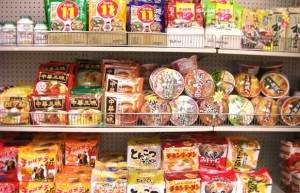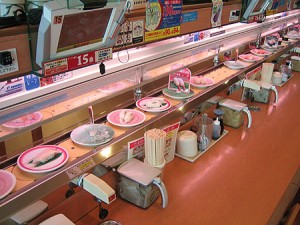Whenever I suggest an Asian restaurant to my friend Michelle, she unconsciously wrinkles her nose a little. Michelle is undoubtedly a pasta kind of girl. I think she’s under the misconception that all Japanese restaurants are terrifying, mysterious places where the only options on the menu are variations of raw fish. Other friends fondly mention Cup Noodles.
But here are two truths regarding these misconceptions: Japanese food varies a lot, and Cup Noodles are tasteless (salty is not flavor!). I want to start off with the Cup Noodles, because I can almost hear the ramen enthusiasts protesting. Instant ramen in and of itself is not bad, and I certainly appreciate the low price of Cup Noodles. I do think it’s somewhat telling, however, that the first two results when you type “Cup Noodles” into Google are “cup noodles cancer” and “cup noodles bad for you.” While I doubt this brand of instant ramen will give you cancer, it’s certainly the least appetizing instant noodles I’ve ever tasted. Maybe I’ve been spoiled, but Cup Noodles pretty much taste like starch and watery soy sauce to me.
That’s not to say that all instant ramen is tasteless, though. Head to an Asian market and you’ll see that there are many different brands and flavors of instant ramen, including soy, pork, and miso. Some of the other brands of cup noodles come in bigger containers as well, which is great for when you’re really hungry and that Cup Noodle styrofoam seems a little on the skimpy side. While there are definitely tasty cup brands of instant ramen, my personal favorite types of ramen are the ones that cook in a pot. Although not as instantly ready as the cup brands, they only take about ten minutes to cook and all the ingredients (other than water) are still included. I’ve always found the sauces in these brands to be better, which makes the extra five minutes totally worth it!
As for the raw fish confusion, it’s simply untrue that Japanese cuisine consists solely of uncooked fish, and taking a look at the menu in any Japanese restaurant confirms this. There are plenty of curries and rice dishes to be found in Japanese restaurants—one of my personal favorite rice dishes is called katsudon. It is a bowl of rice with eggs, thin pork cutlets, and seasoning on top. This type of rice bowl can be made with other types of meat, or even with just eggs and seasoning, for any vegetarians out there. Aside from ramen, there are also other types of noodles, such as soba or udon noodles. These noodles can be served both hot and cold, which make them a great choice on a hot summer night.
Tempura is another nice dish to have in the summer. Simply put, tempura is vegetables or seafood, put in batter and fried. Many people are somewhat wary when they hear the word “fried,” but tempura is not all that unhealthy. For one, it is primarily vegetable or seafood-based. It is also generally not too heavily fried, with the emphasis in the dish being the vegetable or seafood itself. All sorts of vegetables and seafoods can be used in tempura, from eggplant to asparagus to shrimp. Tempura is actually pretty easy to make, as well. My mother makes it fairly often in the summer, and we usually have it with some soba noodles on the side. She makes sliced eggplant, green bean, and onion-and-carrot tempura. The onion-and-carrot tempura are thinly sliced and battered together almost like little bundles, and they disappear absurdly quickly from our table.
Of course, there’s also sushi. Most people are at least familiar with sushi, most likely having tried tuna rolls or California rolls. These are fine sushi choices, but I would urge any sushi fan to try something a little more adventurous. I personally love sushi made with eel, although this sometimes gets me odd looks when I mention it to friends. The fish is very soft, though, and often in sushi it is seasoned with a sauce that is almost sweet—I definitely recommend it!
The other fun aspect of Japanese restaurants that specialize in sushi is that there is sometimes a separate sushi bar. Some sushi bars feature a conveyor belt of sorts, with various sushi dishes on colored plates. Generally, each plate color or pattern corresponds with the price of the sushi dish, so it is easy to check your spending as you eat. Restaurants like these are a lot of fun to go to with groups of people. I once went with my family, and my younger sister had a blast picking up dishes of sushi for us all; she would sit eagerly awaiting her favorite shrimp sushi to come down the conveyor belt.
Maybe if I had suggested a sushi bar like this, I could’ve convinced my friend Michelle that Japanese restaurants are fun and delicious, rather than strange and foreign. Although I didn’t go into this much depth with her during my initial attempt to convince her, she did eventually agree to try out a modern Thai restaurant. And despite her initial reluctance, she ended up enjoying it after all.
Anais DiCroce
More student discounts can be found here!
Download our NEW App from iTunes!
Become a fan on Facebook or follow us on Twitter!
Sign up for our bi-weekly newsletter for more student promotions and coupons or download the coupon booklet here!




